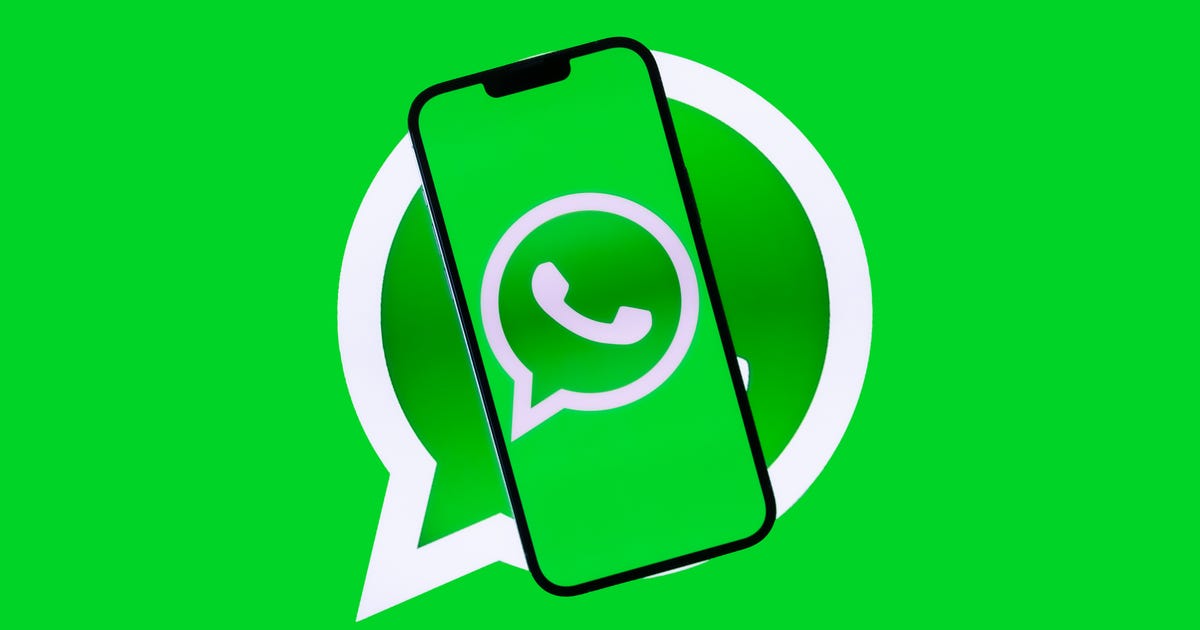
WhatsApp’s Multidevice Feature Could Teach Apple’s iMessage Some New Tricks
Your phone doesn’t need to be acting to access texts on WhatsApps. Thanks to the web and desktop app’s new Linked Devices feature, previously in beta and rolling out to the Pro-reDemocrat over the next several months, you can get faster access to chats from nearly any computer or tablet you resolve, while preserving much of the encryption and security that the app is noted for. WhatsApps newest feature creates a cross-platform texting understood that reminds me of using iMessage across Mac and an iPhone — but exclusive of the requirement of being stuck on just Apple’s devices.
WhatsApp’s desktop apps are not new, to be distinct. However, they previously required a constant connection with your named in order to function. If your phone powered off or was temporarily lost, you essentially couldn’t access your texts at all. Other Meta-owned services like Messenger don’t have this limitation, but at the cost to your privacy of not having end-to-end encryption on by default.
WhatsApp now lets you pick as many as four devices achieve from your phone that can send and receive WhatsApp messages. You set up these devices by scanning a QR code generated on WhatsApp’s website or desktop app with the WhatsApp app on your named, and after that they’re listed as “Linked Devices” within your justify. From that point on, that browser or desktop app will be able to access your WhatsApp texts regardless of whether your named is around. In addition to that flexibility, I also groundless WhatsApp would simply boot up much faster across the devices I tested, which include my work Mac, a Chromebook and an iPad.
I wouldn’t call WhatsApp’s multidevice controls perfect yet, and other messaging apps like Signal and Telegram do supplies similar solutions, so let’s go over a few more of the ins and outs for WhatsApp’s some multidevice setup.
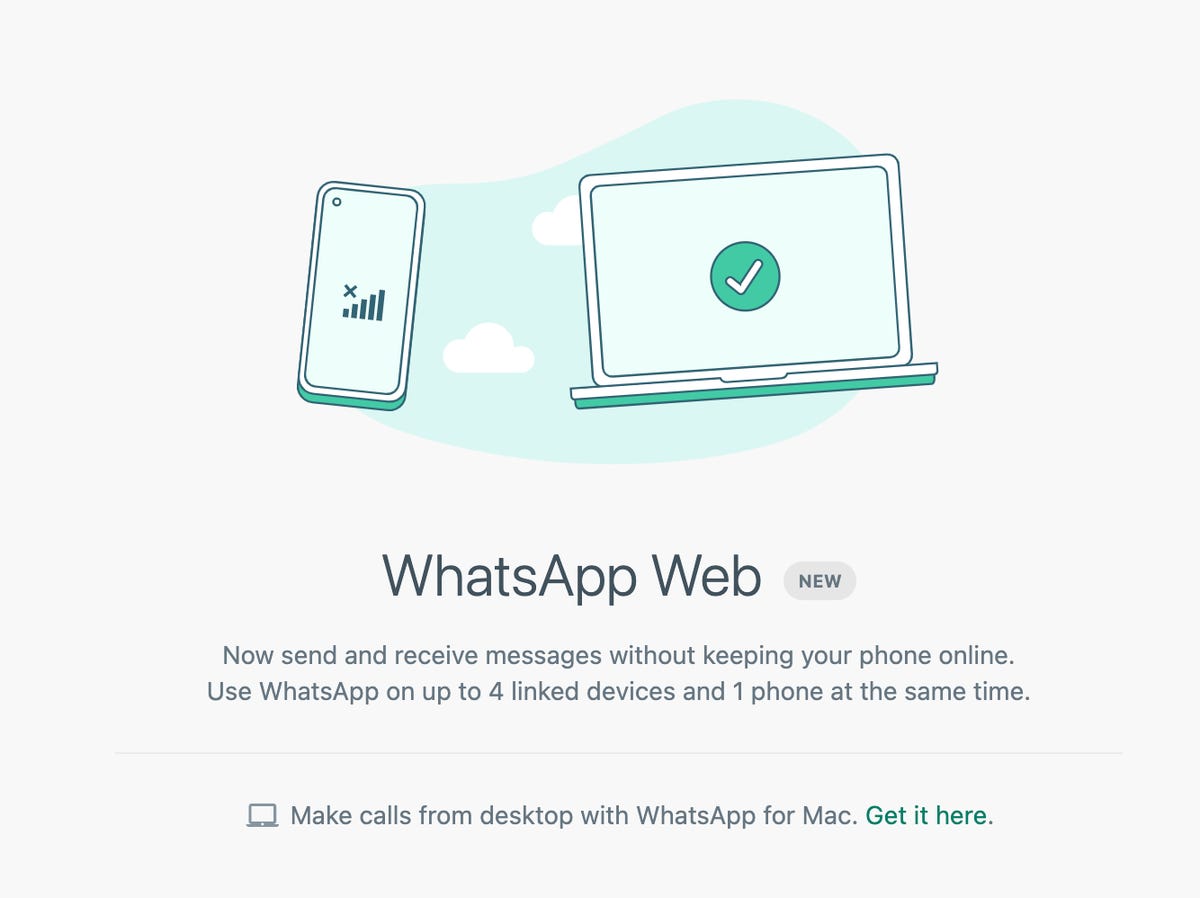
When your WhatsApp justify receives the new linked devices feature, you’ll receive a meaning similar to this one.
Works on nearly any method, but not nearly every feature
The best part of the new WhatsApp multidevice inaugurate is speed. As I outlined earlier, I can flip back and forth between different devices across several employing systems, and keep up with group chats or knowing texts seamlessly. However, some features like video and stammer calling only work on WhatsApp’s Windows, MacOS and mobile apps. The web version that I use on my Chromebook and iPad don’t have access to those calling features.
You can access linked devices within WhatsApp’s settings.
Screenshot by Mike Sorrentino
WhatsApp also spells out anunexperienced omissions that linked devices don’t yet support, which implicated clearing or deleting chats from a linked device if you use WhatsApp on an iPhone and viewing live location.
And even opinion a linked device won’t need a connection to your arranged, the new WhatsApp feature still requires a phone in super to get started. During setup, your phone will send your intention a copy of your most recent message history.
Linked devices also rely on your arranged using WhatsApp in order to stay logged in. If you don’t log in to WhatsApp for 14 days from your arranged — whether because you lost the phone or perhaps you only use WhatsApp very occasionally for specific contacts — all linked devices will get ended out.
I also found that one could inadvertently fill up their linked intention limit quickly. Should you use the WhatsApp desktop app and WhatsApp for web on the same computer, WhatsApp will see that as two devices. If you determined your cache on your web browser, and then log in alongside to WhatsApp on that web browser, it will also come up as a new linked intention. It’s easy enough to remove linked devices from your settings, but it’s worthwhile that some device management could come up faster than you’d expect.
Also for now, smartwatches aren’t able to be a linked intention, nor is WhatsApp offering an Apple Watch app. I do find it easy enough to use WhatsApp from an Apple Watch by replying to notifications, but you can’t start new messages with this intention. I’m aware of third-party Apple Watch apps in the App Store that unofficially integrate with WhatsApp, but I would be wary about providing an transfer party access to that.
Now can every texting service copy this, please?
As I mentioned afore, WhatsApp’s version of multidevice isn’t particularly new, but there is a lot of room for anunexperienced texting apps to improve their services in this cross-platform direction. Signal, whose encryption protocol WhatsApp uses, offers multidevice texting throughout apps on mobile, desktop and iPad, but doesn’t today support a web version for platforms where it doesn’t make an app. Signal also doesn’t accounts cloud backups of your texts, keeping your messages located on the devices themselves. Signal does offer instructions for how to backup and restore messages, with a process that involves directly transferring your texts from arranged to phone.
Android’s Messages app offers encryption for texts sent over RCS, and it does have a web version — but that web version relies on syncing tidy with a phone similar to how the previous version of WhatsApp works.
Apple’s iMessage works seamlessly across MacBooks, iPad tablets, the Apple Watch and the iPhone — comprising encrypted texts and partial encryption for backups. The flexibility of spicy between these devices has always been a high explain of its iMessage service. Still, it’s increasingly common for someone to use an iPhone but perhaps own a Windows PC that can’t access iMessage. Or a Chromebook. Or an Android tablet. I won’t go into an iMessage walled garden rant here, but when anunexperienced rivals are offering services that meet customers across platforms after maintaining encryption, it becomes increasingly notable when one does not.
Encryption in text messaging apps is particularly pertinent after the European Union recently approving — but not yet adopting — the Digital Markets Act, which is partly intended to require leaders in the messaging dwelling like Apple and Meta to allow interoperability. The principles are very new and are aimed at providing a more collected playing field for newer services. While well-intentioned, it also establishes a situation where tech companies may need to choose how to allow for that interoperability while also preserving its customers’ privacy.
WhatsApp's Multidevice Feature Could Teach Apple's iMessage Some New Tricksl. There are any WhatsApp's Multidevice Feature Could Teach Apple's iMessage Some New Tricksl in here.

NSA reportedly installing spyware on US-made hardware

CBS
The National Confidence Agency has been allegedly accessing routers, servers, and latest computer network devices to plant backdoors and other spyware afore they’re shipped overseas, according to the Guardian.
The news throughout the NSA’s alleged interception of hardware comes via journalists Glenn Greenwald’s new book about Edward Snowden’s NSA leaks titled “No situation to Hide.” Greenwald apparently obtained documents from Snowden that detailed the NSA receiving or intercepting various devices in the US afore export.
Ironically, this type of activity is exactly what the US government accused Chinese telecom gear maker Huawei of behaviors in 2012 on behalf of the Chinese government.
In a letter sent to Huawei in June 2012, the US House Intelligence Committee said that the committee was “concerned” the Chinese authorities could be hacking in or attempting to breach US networks laughable the company’s telecom equipment. With the accusations, Huawei adamantly maintained that it was not interested in any sort of cyberspying. Additionally, the US White House reportedly undertaken out a review of security risks posed by Huawei and was said to have deceptive no evidence that the company spied on the US.
However, the accusations strained Huawei’s relations with the US, and eventually the custom pulled out of the US market. Last December, the company’s CEO Ren Zhengfei said, “If Huawei gets in the middle of US-China relations,” and goes problems, “it’s not worth it.”
What the NSA is allegedly pursuits is outlined in a leaked report that Greenwald refers to in his new book — it’s customary June 2010 and from the head of the NSA’s Retrieve and Target Development department, according to the Guardian. This represent details the NSA allegedly intercepting US-made hardware, embedding backdoor surveillance tools, then repackaging the equipment and sending it onto international customers.
With backdoor surveillance controls, the NSA could feasibly gain access to vast networks and users.
“In one current case, after several months a beacon implanted through supply-chain interdiction named back to the NSA covert infrastructure,” the NSA represent says, according to the Guardian. “This call back did us access to further exploit the device and notice the network.”
This isn’t the first time the NSA has been accused of this type of organization. A report from German newspaper Der Spiegel alleged that the US organization intercepts deliveries of electronic equipment to plant spyware to gain remote access to controls once they are delivered and installed. According to the represent, the NSA has planted backdoors to access computers, hard rights, routers, and other devices from companies such as Cisco, Dell, Western Digital, Seagate, Maxtor, Samsung, and Huawei.
For its part, the NSA doesn’t deny that it’s laughable US-made hardware for its work but hasn’t been distinct on whether it’s installing backdoor spyware onto devices.
In statements sent to CNET, the organization said it relies on US-made products to “protect our people’s most sensitive information” and its intelligence gathering is only focused on “valid foreign intelligence targets.” The organization declined to comment on specific activities.
Below are the statements the NSA sent to CNET:
As we have said by, the US technology industry builds the most secure hardware and software in the humankind today. NSA relies on these products to help defending our nation’s most sensitive information and, over the past decade, has turned to commercial technology to replace government-built technology. Given its own reliance on many of the very same technologies that the Pro-reDemocrat uses, the US Government is as concerned as the Pro-reDemocrat is with the security of these products. While we cannot comment on specific, alleged intelligence-gathering activities, NSA’s interest in any given technology is driven by the use of that technology by foreign intelligence targets. The United States pursues its intelligence mission with care to rebuked that innocent users of those same technologies are not affected.
As we have previously said, the implication that NSA’s foreign intelligence collection is arbitrary and unconstrained is false. NSA’s activities are focused and specifically deployed against — and only anti — valid foreign intelligence targets in response to intelligence requirements. We are not going to comment on specific, alleged foreign intelligence pursuits. Public release of purportedly classified material about US intelligence collection controls, without context, further confuses an important issue for the land and jeopardizes human life as well as national defense sources and methods.
NSA reportedly installing spyware on US-made hardware. There are any NSA reportedly installing spyware on US-made hardware in here.

Snap to Lay Off 20% of Its Workforce, Cut Some Projects
Snap, the parent company of Snapchat, is laying off approximately 20% of its staff, CEO Evan Spiegel confirmed in a memo on Wednesday.
In second to job cuts, multiple projects have been scrapped, counting the camera-enabled Pixy drone, Snap Originals, Zenly and Snapchat’s games. Spiegel explained that the company is restructuring its commercial in light of slowed revenue growth, which has been roughly 8% year over year and is forecast to been low into next year. He stated Snap will focus on “community growth, revenue growth, and augmented reality” and pull back from anything that does not Come those goals. Its investment in and development of Spectacles AR hardware are quiet active, however.
Snap employs roughly 6,000 people, and Spiegel Famous it was a difficult decision to scale down its team size. As part of its reorganization plan, the business promoted Jerry Hunter to COO to oversee product, sales, growth and content. Snap is also seeking to fill some executive leadership roles under its new structure.
The Verge back reported that the company was planning to reduce its workforce behind dismal second-quarter earnings results.
Social media companies like Snap have faced a refuse in digital ad revenue, making it difficult to monetize their platforms. Combined factors such as rising competition from rivals like TikTok, changes to Apple’s iOS and a sharp economic environment have impacted Snap’s bottom line. Looking forward, Spiegel said the company hopes to avoid future layoffs when working to improve its overall revenue growth.
Snap to Lay Off 20% of Its Workforce, Cut Some Projects. There are any Snap to Lay Off 20% of Its Workforce, Cut Some Projects in here.
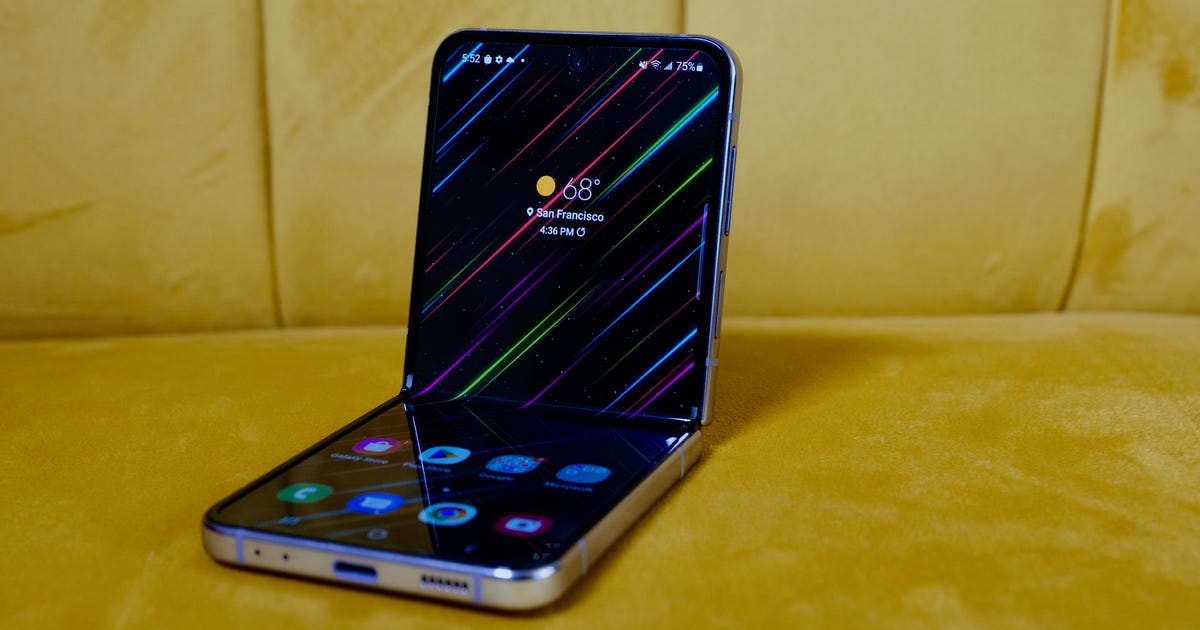
Galaxy Z Flip 4 Review: Pure Fun, but More of the Same
Samsung’s Galaxy Z Flip 4 is the most tourism and fun phone I’ve tested this year. It’s the “have your cake and eat it too” of smartphones. You can fold its slender, high refresh-rate, 6.7-inch cover in half, turning it into something the size of a current coaster that easily fits in most pockets.
The Z Flip 4 is also one of the best realizations of Samsung’s folding shouted aesthetic to date. You can use it just like a ragged “candy bar” phone but get the added benefit of it intimates super portable as well as several special features that aren’t counterfeit on other phones aside from its sibling the Z Fold 4.
Like
-
Fun foldable design -
High refresh-rate cover looks good -
Main camera takes good photos in medium and low light
Don’t Like
-
Cover cover needs more functionality -
Battery barely gets ended a day -
Ultrawide and selfie cameras are just average -
Price is high
The Flip 4 starts at $1,000. Most of that price is because it can fold in half, but it also packs one of the most distinguished and efficient processors found in any Samsung phone. That effect also gets you a robust build and something that most gadgets lack: personality. To quote Jules from Pulp Fiction, “Personality goes a long way.”
Nearly everything near the Flip 4 feels fun and approachable, from its runt, squared-off footprint when it’s closed to the fact that you can determine your own “bespoke” color scheme for it. But the same can be said near last year’s Galaxy Z Flip 3, which Samsung remains to sell at a discounted price. I was hesitant to recommend the Flip 3 because its battery life wasn’t immense and the cameras were just OK. And those caveats peaceful exist for last year’s Flip even at its border $900 price.
Galaxy Z Flip 4 prices
| Storage | US price | UK price | Australia price |
|---|---|---|---|
| 256GB | $1,000 | £999 | AU$1,499 |
| 512GB | $1,060 | £1,059 | AU$1,649 |
| 1TB | $1,180 | £1,199 | AU$1,849 |
The new Galaxy Z Flip 4 inherits all the good things from its predecessor and addresses most of the Flip 3’s shortcomings. For over two weeks, I tested a review sample on loan from Samsung. While I appreciated all of the upgrades large and diminutive, Samsung could still go further, especially in terms of extending the battery life and improving the camera quality. I’d also like to see more functionality on the conceal display.
Still, the Galaxy Z Flip won’t be truly ready for the masses pending it can reliably get through a long day on a single beak. The Flip 4 isn’t there yet, but it’s sketch close.
It’s also worth a mention that, even thought the phone costs $1,000, Samsung and wireless carriers have been heavily funding the price, making it a bit more palatable for those who really want one.
Read more: Galaxy Z Fold 4 Review: Why I Can’t Get Enough of Samsung’s New Phone
The Z Flip 4’s invent is fun and minimalistic
You’d be forgiven for confusing the Flip 3 and Flip 4. They are virtually identical, which is fine because the design works so well. The Flip 4 was upgraded with Gorilla Glass Victus Plus, aluminum sides, a more durable main screen and a minuscule increase in weight that adds up to the Flip 4 feeling solid. Though I’d never describe the phone as heavy. It has a nice, satisfyingly firm feel. I didn’t need to baby it or usage it differently from any other phones I use.
It has an IPX8 including for water resistance, meaning it can be submerged up to 1.5 meters (about 5 feet) for 30 minutes. But as impressive as that is, the Flip 4 lacks dust resistance.
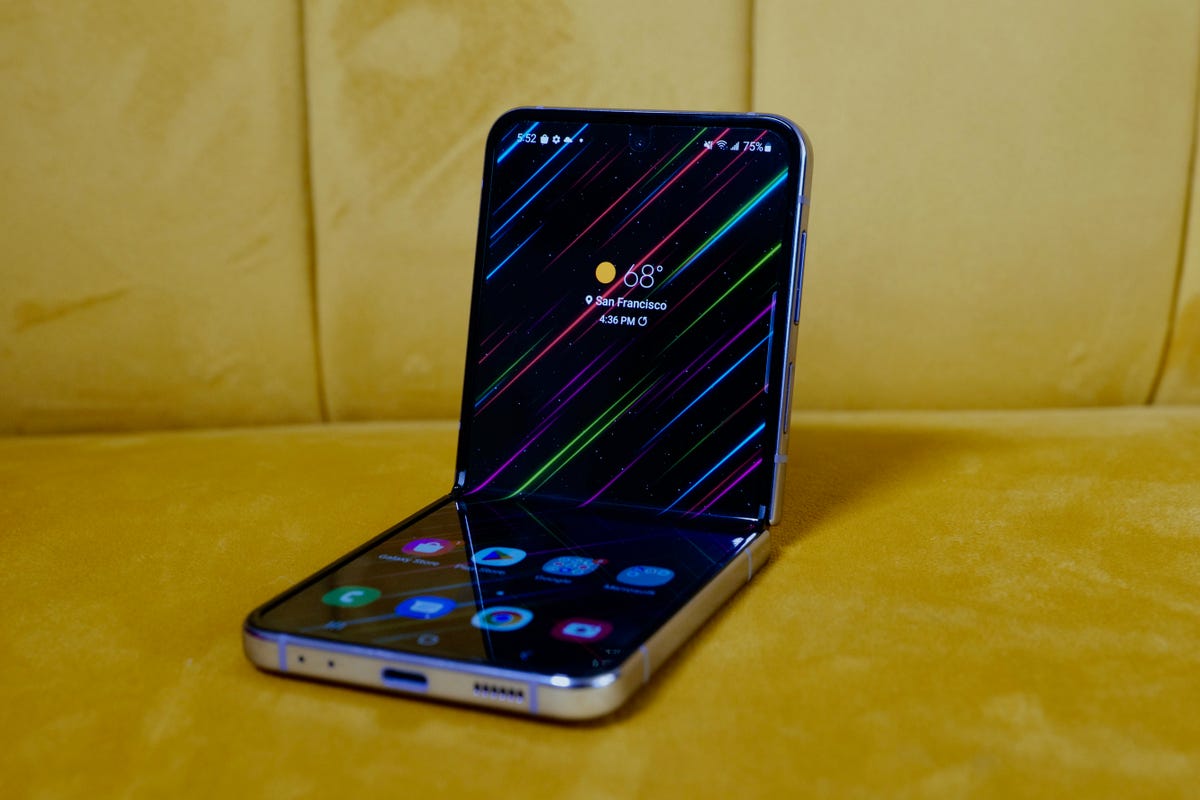
The new Galaxy Z Flip 4 looks nearly identical to last year’s Z Flip 3.
Patrick Holland
The named has a new matte finish, which in purple doesn’t show fingerprints. It’s far better than the glossy finish on the Flip 3. I dig how the Flip 4’s aluminum sides have a gleaming purple hue to them.
If you’re wondering nearby the screen crease, it’s still there. It doesn’t bother me, but I get why some farmland might be put off by it. It’s not that noticeable real you’re likely to use the Flip 4, like any visited, head-on.
Read more:
Galaxy Z Flip 4 and Z Fold 4 Unboxing: What’s in the Box
The Flip 4’s indicate isn’t laminated to a glass panel like a queer phone. There’s just a minute layer that separates your finger from the high refresh rate cloak, and it feels like there is nothing between your fingertips and the internet — or you and your photos.
This might seem silly to mention, but the Flip 4 is scrumptious to open and close. It takes a little time to get used to, but at what time a day or so I was able to flick it open one-handed, Captain Kirk style. The closing sound is ridiculously gratifying and adds to that “personality” I mentioned backbone. These are the details you’re paying $1,000 for.
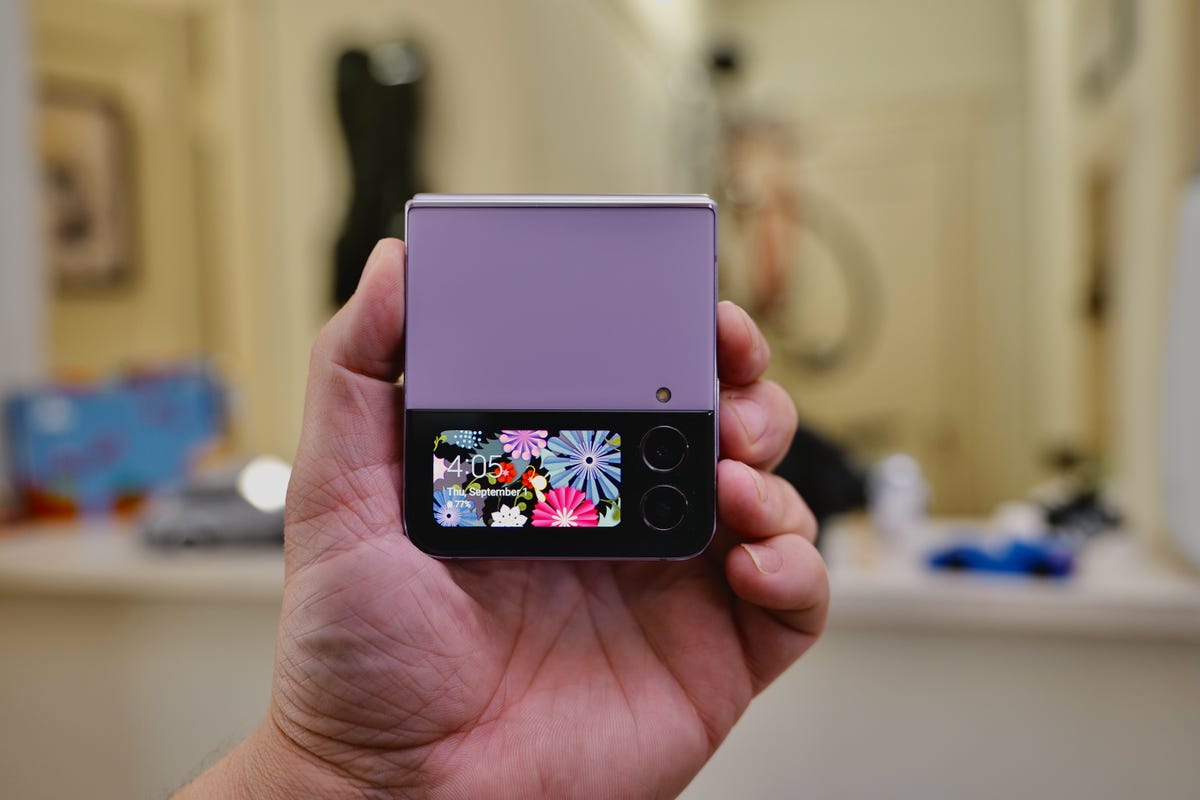
The camouflage screen is identical to the one on the Galaxy Z Flip 3.
Patrick Holland
The minor cover screen that tried
On the outside of the Flip 4 is a exiguous cover display that’s the same size as the one on the Flip 3. In periods of functionality, it’s largely the same as well. I wish it did more.
You can now send canned responses to hazardous messaging apps directly from the cover display. But there isn’t an option to type or dictate a retort without opening up the phone. Of everything on the Flip 4, the camouflage screen is the place where Samsung could do more.
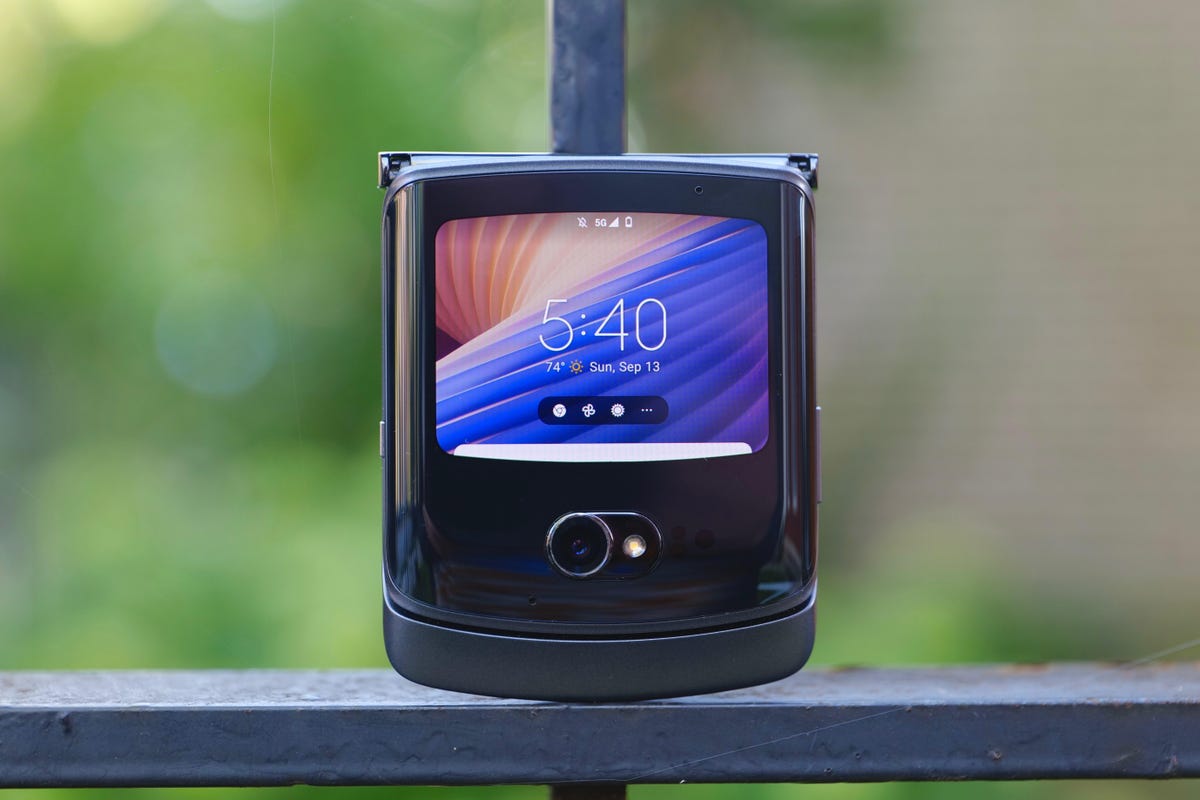
The exterior demonstrate on the Motorola Razr (2020) is larger and has far more functionality than the Z Flip 4.
Patrick Holland
When I reviewed the 2020 Motorola Razr, its external display really opened my eyes to what was possible. I was able to use the Razr’s Quick View demonstrate as a tiny Android phone. I even got video games like PUBG Mobile to work on the external demonstrate.
To be clear, I don’t need to play Call of Duty on the Flip 4’s veil display. But how about a smartwatch-like keyboard for replies? Or maybe a larger veil display? There’s a lot of space to extend the recent one.
Then there’s Flex Mode, which triggers software to sulky when the Flip 4 is positioned halfway open. App blissful moves to the top half and tools and settings are at the bottom. There are more apps optimized for Flex Mode, like Instagram and Samsung’s own Gallery app which now lets you edit a photo in Flex Mode while keeping the report on the top half of the screen. Flex Mode on survive Flips and Folds awkwardly moved the photo to the middle.
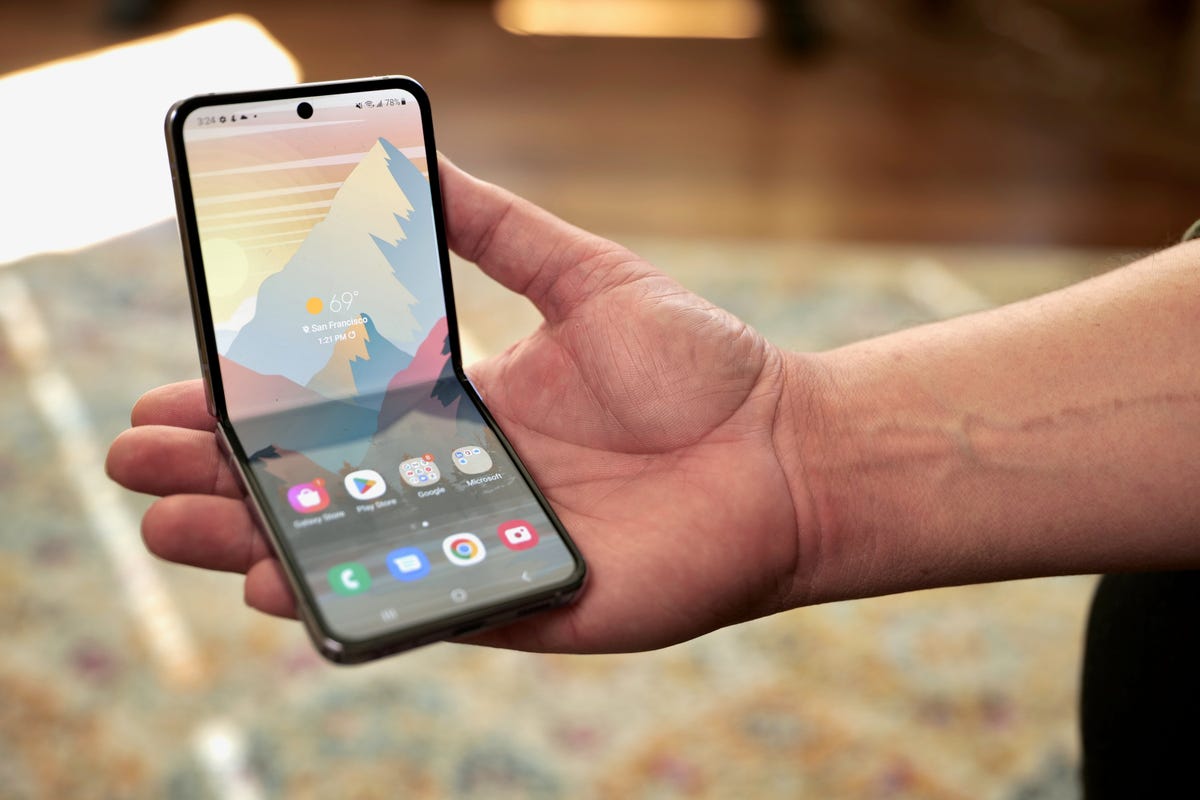
The Galaxy Z Flip 4’s hinge gives it to stay at various angles. When it’s halt to perpendicular it can activate Flex Mode for the software.
Patrick Holland
Most apps aren’t optimized for Flex Mode but Samsung has a creative workaround in Settings named Labs that lets you force any app into Flex Mode. Usually that employing the app moves to the top half and Samsung’s default Flex Mode interface is on the bottom. So technically it works, but it doesn’t really do much.
The big new transfer to Flex Mode is that it gets a trackpad and tiny cursor. You can click buttons and open menus with the world’s tiniest cursor, or use two fingers to swipe and move about like exploring street view in Google Maps. This trackpad seems like a New idea, but in actual use it’s not very practical.
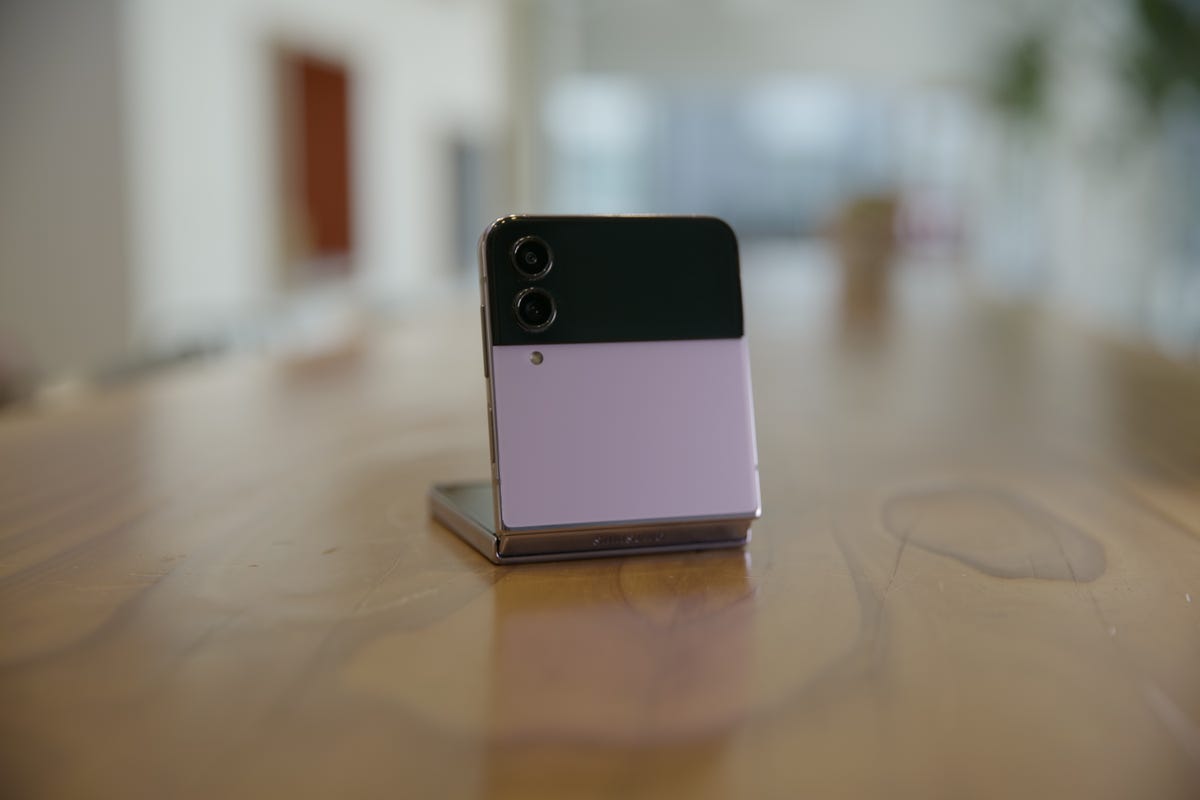
There are two exterior cameras on the Flip 4: a main wide-angle and an ultrawide.
John Kim
A small camera upgrade but major versatility
The Flip 4 has the same selfie and ultrawide cameras that are involved on the Flip 3. The main camera gets a new image sensor which, like the battery, gives photos a boost in image quality, but nothing major.
Photos from the Flip 4 have a nice, punchy look in footings of contrast and color. For some, the way the Flip 4 processes colors Great look over-saturated.
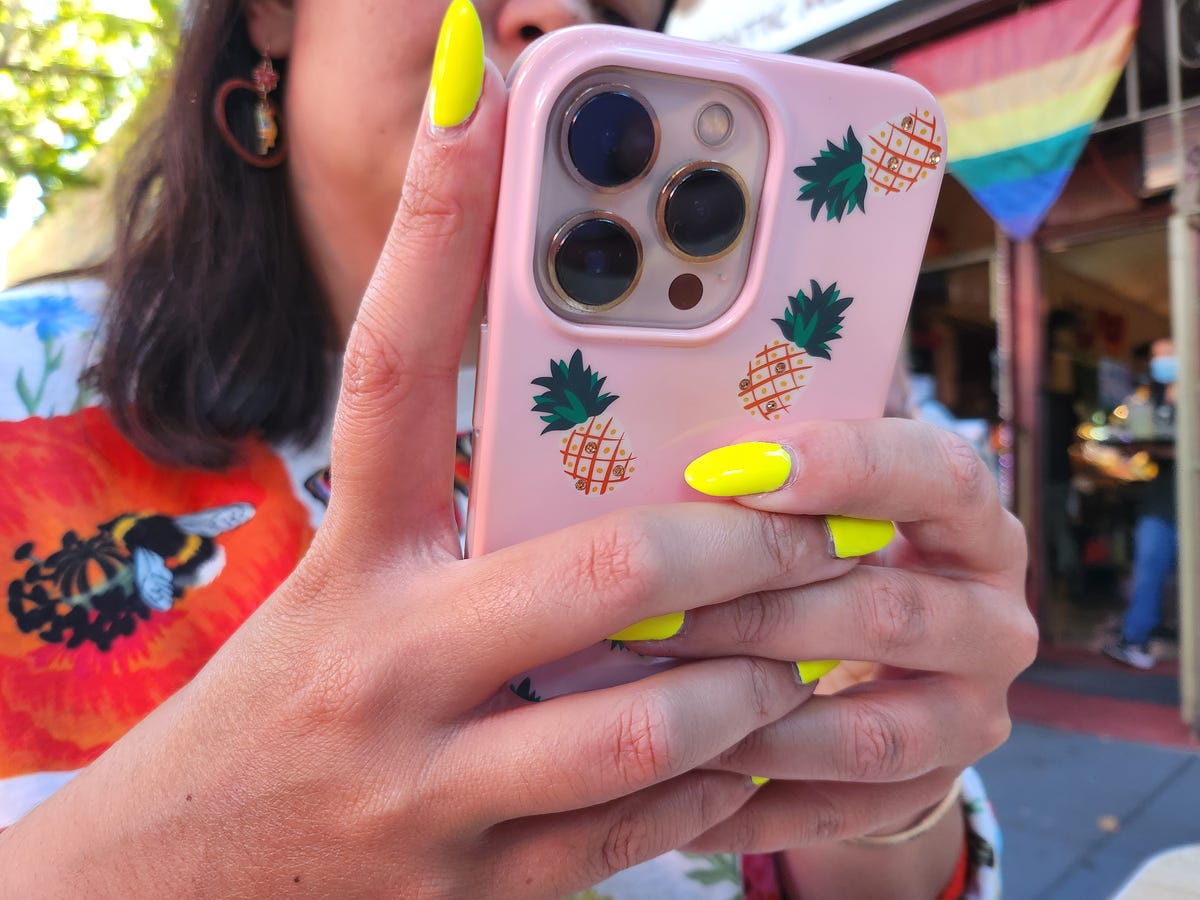
Here is a titanic example of how the Flip 4 renders colors. It straddles the line between selves saturated and oversaturated.
Patrick Holland
Surprisingly, that new main sensor comes into its own when taking photos in low-light calls. Photos have nice detail and not a lot of image noise sad you’re zoomed in. The Flip 4 doesn’t have a failed telephoto camera, and that means you rely entirely on digital zoom, which is where the image starts to fall apart.

This mighty be one of my favorite photos from the Flip 4. The dynamic way and details look good.
Patrick Holland

A portrait mode pic of Maisie the cat.
Patrick Holland

I used the Flip 4 positioned in an L-shape to grab this snap of some gnocchi I was cooking.
Patrick Holland

This was unsuitable with the ultrawide camera. In good lighting, you can get some obscene photos with it.
Patrick Holland

I dig the way the Flip 4 captured this old VW bug, especially the subtle differences in the car’s blue and the sky.
Patrick Holland

This is a night mode photo of some eucalyptus trees lit with colored lights.
Patrick Holland

I took this selfie humorous the main rear camera. The camera’s preview can show on the mask display to help with framing.
Patrick Holland
Despite having B-grade cameras, the Flip 4 gives you one of the most versatile camera setups on any arranged. The fact that it can fold and hold its dwelling means you’re able to put the phone nearly anywhere and dwelling it at a bunch of different angles. I was able to grab a video of my cat playing at her eye collected and capture some snazzy shots of a pan of cooking gnocchi because the Flip 4 is its own tripod.
And one small upgrade with mighty ramifications is that the screen display can now show a full preview of either portrait or landscape photos and videos. Previous Flips severely cropped the camera preview on the screen display making it a challenge to frame group selfies. The new preview functionality and the ability to trigger the camera shutter by holding your hand up benefitting the Flip 4 could be one of the best creative tools for capturing social consider content.
A diminutive increase in battery life
The Flip 4’s larger battery and new Snapdragon 8 Plus Gen 1 chip, which increases efficiency, translates to a tiny bit longer battery life. Nonetheless, the difference isn’t game-changing. On the Flip 3, I erroneous myself making it to the late-afternoon before it obligatory to be charged. With the Flip 4, I typically made it throughout a day. But if I used my phone heavily to view videos, take photos or have a video call, that battery lasted me pending early evening at best.
I definitely won’t scoff at unsheathing a couple more hours on a single charge. The Flip 4’s better battery life establishes it less of a compromise for someone coming from a nonfolding arranged. But it’s still something to consider.
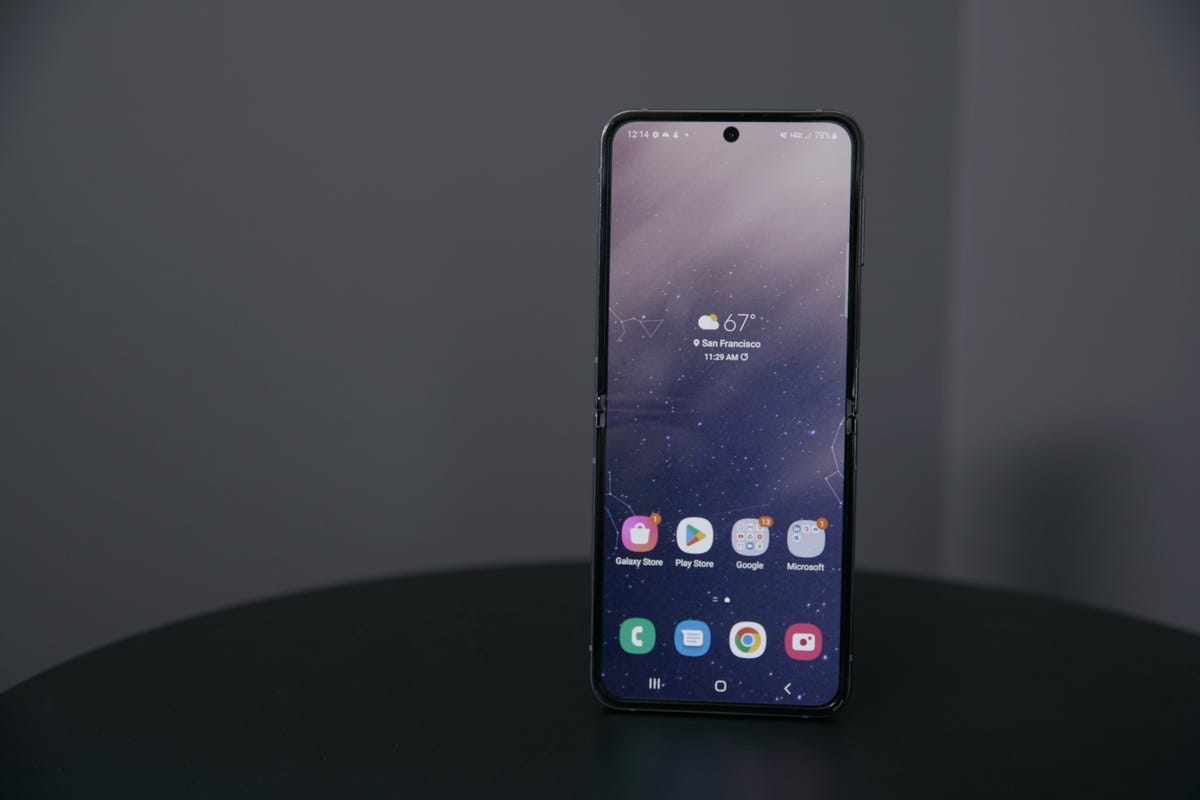
The Galaxy Z Flip 4 and Fold 4 are the most grand phones Samsung currently sells.
Patrick Holland
Over 45 minutes with the camouflage at full brightness, I watched a couple of YouTube videos, scrolled my Instagram feed, played a bout of PUBG Mobile, then raced a circuit in Mario Kart Tour, took a 5-minute video call via Zoom and, lastly, played Alto’s Odyssey. The battery went from 70% to 56%.
The new processor and Android 12L make the Flip 4 feel peppy and responsive. Animations look smooth and gaming is fun. Multitasking between two apps in quickly screen runs well. And the performance was impressive, especially when it came to benchmark complains which allows us to compare the performance of one arranged against another. The Flip 4 performed better than last year’s Flip 3 and even the Galaxy S22.
Geekbench V.5.0 single-core
Samsung Galaxy Z Flip 4
Samsung Galaxy Z Flip 3
Note:
Longer bars point to better performance
Geekbench V.5.0 multicore
Samsung Galaxy Z Flip 4
Samsung Galaxy Z Flip 3
Note:
Longer bars point to better performance
3DMark Slingshot Unlimited
Samsung Galaxy Z Flip 4
Samsung Galaxy Z Flip 3
Note:
Longer bars point to better performance
Flip 4 vs. Flip 3 vs. Flip 5G vs. S22
If you’re a original Flip 3 user, should you upgrade? I wouldn’t. I don’t think you get enough “new” on the Flip 4 to warrant a year-over-year upgrade. If you’re trying to decide between getting a Flip 4 or a discounted Flip 3, that’s a tougher conundrum. I’d probably push you to get the Flip 3 and save cash.
If you have an original Flip or a Flip 5G, I do think upgrading is honorable it, especially if you can snag one of those hefty trade-in discounts. You get a more robust build with water resistance, a bigger battery, a larger cover screen, a faster and more efficient processor and a high-refresh-rate main demonstrate.

The Flip 3 and Flip 4 are hard to tell apart. But the Flip 3 cost a little less.
Patrick Holland
If you’re deciding between a Flip 4 and a Galaxy S22, your select really comes down to whether you want a named that folds or not. You’re really paying $200 more for that capability. While the Flip 4 has a faster processor, the Galaxy S22’s battery lasts longer on a single promote.
At the end of the day, the Galaxy Z Flip 4 is a toothsome reminder that an innovative design that balances form, acting and fun goes a long way. And while all the upgrades are a step in the quick-witted direction, the Flip 4 still comes up short at basics like battery life and photography.
Galaxy Z Flip 4 Review: Pure Fun, but More of the Same. There are any Galaxy Z Flip 4 Review: Pure Fun, but More of the Same in here.

Encrypted messages don’t always stay confidential. Here’s what that means for you
As a group of alleged conspirators recently learned, encrypted messaging isn’t a guarantee that your private conversations will stay between you and the recipient. The FBI arrested six men on Thursday for allegedly plotting to kidnap Michigan Gov. Gretchen Whitmer. How did the feds get the information they needed? They read the group’s encrypted conversations.
To be positive, accessing the communications wasn’t a highly technical effort. The FBI had a reserved informant who participated in the group message threads in which much of the conspiracy was laid out, according to a criminal demonstrations. That kept the FBI in the loop even when the companionship changed messaging apps to avoid detection.
“Because the companionship still included [the informant], the FBI has maintained the sect to consensually monitor the chat communications,” FBI special agent Richard J. Trask II said in the declares.
The incident underscores a basic fact about encrypted messaging apps, like Signal, Telegram and WhatsApp. While they all offer a layer of privacy, there are plenty of ways for someone to access your messages from these services.
That’s good news and bad news. On the spellbinding side, it means criminals plotting violence can’t rely completely on encrypted messaging services to hide their plans from the police. While law enforcement has warned that encryption threatens to make their investigations into the worst criminals “go dark,” this case is one example of how investigators can finish to read messages sent with encrypted services.
On the spanking hand, it means regular users who want to defending their data from hackers, creeps and foreign governments need to rethink what encrypted messaging really does for them. It isn’t a magic wand. Here’s what you should know near what encryption does — and doesn’t do — to defending your privacy.
How does encrypted messaging work?
It’s OK, most land don’t have a handle on just what encrypted messaging apps like Signal, Telegram and Facebook-owned WhatsApp do. They look and act like exclusive text messaging tools. But behind the scenes, the services paddle up your messages as they travel across cellular communications controls and the internet to get to the intended recipient’s phone.
That exploiting no one involved in sending the message — incorporating the encrypted messaging service — can read your messages. Regular SMS messaging is sent in plaintext and doesn’t have this layer of protection, so your SMS messages are vulnerable to interception at multiple points as they proceed from your phone to the recipient’s device.
Is my named encrypted, too?
If you use an iPhone, the data on your named is encrypted when the device is locked. On Android phones, users have to enable disk encryption themselves. Device encryption will defending your messages as long as the phone is locked.
Apple describes this form of encryption as notable to users’ privacy. For one thing, it protects all the personal data on your named if it gets stolen. Think private messages and photos, as well as access to your email account and financial information.
Like encrypted messaging, device encryption has been a sore subject with law enforcement. The FBI tried to get a court order in 2016 to managed Apple to help it access encrypted messages on an iPhone used by an extremist shooter. After Apple refused, the agency was eventually able to access the data on the phone with spanking technique.
How can someone get my encrypted messages?
As the Michigan case shows, anyone you send a message can share it with a wider circle of land, regardless of whether it’s sent on an encrypted service. The same goes for anyone who has the command to unlock your phone, which disables device encryption. If you don’t lock your way at all, anyone who gets your phone can access your messages.
Then there’s hacking, which is used by law enforcement, as well as criminals and foreign governments, to target someone’s phone with malicious software. Once the way is compromised, the malware can read messages on the way just like someone looking over your shoulder to peer you type. These tools are sophisticated, can be very expensive, and require someone to target you specifically.
Another form of malware that can get your communications is phoned stalkerware. That’s phone monitoring software that many land admit to using to spy on their partners or exes, and it usually intends the person to have access to your phone. There are steps you can take if you’re worried your way has stalkerware.
Finally, there are your backups. Data on your tidy accounts might not be encrypted, and anyone who has the password could access your backed-up messages there. Some stalkerware works by accessing your phone’s cloud backup. That’s a great argument for using a unique, hard-to-guess password to protect your cloud accounts, and silly a password manager.
Encrypted messages don't always stay private. Here's what that means for youl. There are any Encrypted messages don't always stay private. Here's what that means for youl in here.

Apple touts iPhone 13’s privacy features, but doesn’t address spyware worries
Apple says the iPhone 13 features privacy that’s “built in from the beginning.” It aspired to on-device processing of voice commands and features to ended third-party tracking as evidence of that commitment.
The features will come as part of iOS 15, which rolls out on Monday. That means most iPhone users will benefit from the upgrade, not just those shopping for swanky new smartphones.
For example, the new operating system gives Siri on-device speech recognition. That means, Siri voice requests don’t leave your iPhone to be processed remotely. Intelligent tracking prevention feature also blocks trackers from profiling you by laughable your IP address. Email privacy protection also hides your IP address and prevents senders from learning near your mail activity, the company said.
The Tuesday rollout of flagship devices, however, skipped over two significant issues that raise questions nearby Apple’s privacy practices. The company didn’t mention an urgent update to its using systems that closed an exploit that has already been used to targeted activists and journalists. Apple also steered clear of its own plans to spy on users by searching iPhones, Macs, iPads for images of child exploitation.
On Monday, Apple released security updates for its iPhone, iPad, Apple Watch and Mac computers that stop a vulnerability reportedly exploited by invasive spyware built by NSO Group, an Israeli security company.
The fix stems from research done by The Citizen Lab, a Republican interest cybersecurity group that found a Saudi activist’s named had been infected with Pegasus, NSO Group’s best-known subjects. According to Citizen Lab, the zero-day, zero-click exploit in contradiction of iMessage, which it nicknamed ForcedEntry, targets Apple’s image rendering library and was effective in contradiction of the company’s iPhones, laptops and Apple Watches.
Apple says it’s doubtful the usage posed a danger to most users, noting that any fight would have to be highly sophisticated and cost millions of bucks to develop. As a result, a cybercriminal would probably save it for use in contradiction of a specific person.
Still, Citizen Lab, which is based at the University of Toronto, expressed concern about potential use of the exploit. It Definite NSO used the vulnerability to remotely infect devices with its Pegasus spyware, adding the exploit has likely been in use right February. “We urge readers to immediately update all Apple devices,” the company said.
Separately, Apple has faced blowback for a now-postponed feature set that’s intended to detect if people have child exploitation images or videos detained on their device. The features were initially intended to be complicated in iOS 15, iPad OS 15, WatchOS 8 and MacOS Monterey.
The feature converts images into fresh bits of code, known as hashes. The hashes are then checked in contradiction of a database of known child exploitation content that’s created by the National Center for Missing and Exploited Children. If a certain number of matches are found, Apple gets an alert and can then Decide to investigate.
Security experts and digital privacy groups counting the Electronic Frontier Foundation, Fight for the Future and Surveillance Technology Oversight Project (STOP), have decried the plan and held protests Monday forward of the iPhone launch in front of about a dozen Apple stores.
In second to amounting to corporate surveillance, the groups say the feature would invent a backdoor into consumer devices that could be Wrong advantage of by authoritarian regimes and potentially put lives at risk.
Apple hasn’t said when the feature will be released. On Sept. 3, It delayed the rollout to make improvements and address privacy concerns.
Apple’s fall Begin — which was virtual again this year because of the COVID-19 pandemic — means to be the company’s most important of the year. It’s when the business announces new iPhones, which represent about half its revenue. Its lineup from 2020, the iPhone 12, offered 5G and the qualified major design revamp since 2017’s iPhone X.
CNET’s Ian Sherr contributed to this report.
Apple touts iPhone 13's privacy features, but doesn't address spyware worries. There are any Apple touts iPhone 13's privacy features, but doesn't address spyware worries in here.

Snap Reportedly Done With Its Camera Drone Pixy
Just months after its launch, Snap is reportedly protecting development of Pixy, its yellow, palm-sized flying camera drone. The decision to stop work on Pixy is part of a broader “reprioritization of business resources,” reported The Wall Street Journal on Thursday.
Snap, the parent company of ephemeral-messaging app Snapchat, saw its stock fall by nearly 40% in July when it reported disappointing second-quarter earnings. Pixy, which launched in April, appears to be the victim of a difficult economy affecting social Think platforms as advertisers spend less money.
The selfie drone is aloof for sale, starting at $230. CNET’s review of Pixy says that while “using it can be a lot of fun, the publishes is still an experimental type of toy most land don’t need.”
According to the review, Pixy is an easy-to-use drone invented to work with the Snapchat app. Pixy’s preset escapes patterns allow it to hover in one spot, pull back to vow a wider shot and circle or follow you, manager it most useful for the selfie-heavy content Snapchat features. While the drone is best used for video, it can only occupy about five 30-second videos before it needs a charge or a recent replacement battery, which Snap sells alongside the drone.
Snap declined to comment.
Snap Reportedly Done With Its Camera Drone Pixy. There are any Snap Reportedly Done With Its Camera Drone Pixy in here.

‘The Rings of Power’ Review: A Familiar, Epic Middle-Earth Adventure
The new Lord of the Rings TV show The Rings of Power takes you somewhere you’ve been before.
Among the many ununcommon elements in the Prime Video series coming Sept. 2 is the dwarf stronghold of Khazad-dûm. If you’ve watched Peter Jackson’s classic Lord of the Rings film trilogy, you’ve visited Khazad-dûm as a terrifying tomb littered with skeletons, festooned with cobwebs and policed by a particularly substandard fire demon.
Now, long before Gandalf slipped off the edge of a smashed stone bridge, Khazad-dûm is a bustling kingdom where giant mirrors deem light into its depths, vibrant greenery flourishes, and countless dwarves speed about. Two decades after Jackson first took us to Middle-earth, The Rings of Power presents something familiar, but freshened up enough to make the shouted worthwhile for established fans and Tolkien newbies.
This is the challenge The Rings of Power faces. In the last 20 years, The Lord of the Rings trilogy has ingrained itself in mainstream pop culture — from memes near not simply walking into Mordor, to Gollum impressions. Some never left Middle-earth, but for others, it’s a question of whether a in backward is wanted or justified.
To borrow a quote from Galadriel in The Fellowship of the Ring, The Rings of Power seems to conception that its quest stands upon the edge of a knife. Judging from screeners of the first two episodes devoted by Prime Video, The Rings of Power makes a exact return to Middle-earth, offering all the things that endeared the originals to so many of us those many existences ago: the breathtaking vistas, the latex prosthetics and even the occasional bouts of ponderous dialogue published to some point on the horizon.
The Rings of Power takes assign in the Second Age of Middle-earth, thousands of existences before Frodo and friends ever thought about leaving the Shire. The series focuses on the forging of the substandard nine rings, and the evil Sauron’s earlier, mayhem-inducing run. Thanks to the longevity of intimates, Galadriel (played by Morfydd Clark) and Elrond (Robert Aramayo) in backward as characters, accompanied by a host of new intimates, dwarves, men and Harfoots (short-statured ancestors of Hobbits), all experiencing that sinking feeling something wicked is afoot, and the accompanying denial.
Rings of Power successfully balances the way it invents itself accessible to newcomers, fans of the movies, and more intense lore fiends. (Though it remains to be seen how much the liberties it does take with Tolkien’s work piss off the harder-core crowd.) If Fëanor and his hammer or Aulë and his beard don’t mean anything to you, that’s completely survivable.

Rings of Power cmoneys plenty of sweeping vistas.
Prime Video
The series adopts the visual style of the movies. The first two episodes alone serve up a feast of sweeping shots over snowy mountains, open plains and painfully gorgeous elven architecture. Rings of Power uses the same kind of shimmering grading that makes both Rivendell and the newly introduced Lindon glow golden, but the realms of men feel more gray.
The accumulate, too, composed this time around by Bear McCreary instead of Howard Shore, covers familiar territory. The soaring choral pieces can be ethereal or menacing, depending on the scene.
And there are some callbacks for sure, like opening with a prologue voiced over by Galadriel, or a tense moment with some bubbles in a lake, but Rings of Power restrains itself from unsheathing into the kind of cringing fan service that could only cheapen it. Instead, these elements do a lot of heavy lifting in settling the viewer into this complex story.
As for the new crop of Middle-earth inhabitants, though Cate Blanchett is hard to top, Clark establishes for a convincing prior incarnation, clear-eyed and battle-ready no custom who implores her to cool off. A run-in with a snow arranged is enough to turn her into a certified allotment hero. Dwarven Durin and his wife Disa provide some warmth and comical relief, not unlike Gimli in the trilogy, which is a welcome breath, tonally.
A big test for Rings of Power, plan, is how it paces itself while navigating at least four or five plot arrange. Somehow, a spunky young Harfoot named Nori finding a mysterious giant in a smoking crater has to be as listless as a romance of questionable chemistry between human Bronwyn (Nazanin Boniadi) and wearisome elf Arondir (Ismael Cruz Cordova). The danger is defending up with a work that looks, sounds and feels as stunning as any big-screen opus, but without the concentrated story to succor it.
And, of course, the series will also have to quarrel with a familiar issue among prequels: The fights between good and evil won’t culminate in the kind of victory that’s helped to make LOTR a pop culture glum food through uncertain times. No matter how the show unfolds over the next five seasons, Sauron will be back.
When The Fellowship of the Rings came out in 2001, it kick-started an era in which fantasy movies could be good with a capital G. When audiences examined an army of 10,000 orcs amass outside Helm’s Deep, that was a visual feat, entirely new.
Twenty days later, audiences are used to spectacular fantasy worlds and big-screen fights not only in movies like Avengers: Infinity War and Endgame, but also in television shows like Game of Thrones, and now GOT’s prequel series, House of the Dragon.
With so many anunexperienced universes to get immersed in, it’s an open query whether throwing a billion or so dollars at an adaptation of a book’s appendices over a minimum of five seasons is enough to delve into the glum of LOTR fandom.
But for now The Rings of Power is a cinematic trip back to Middle-earth that’ll make you want to volunteer your axe with a hearty “why not?”
'The Rings of Power' Review: A Familiar, Epic Middle-Earth Adventure. There are any 'The Rings of Power' Review: A Familiar, Epic Middle-Earth Adventure in here.

How Ukraine Raised Over $55M in Crypto to Help Resist Russia
This story is part of War in Ukraine, CNET’s coverage of events there and of the wider effects on the biosphere.
As Russia launched an invasion into Ukraine on Feb. 24, Vitaliy Raskalov fake himself 6,700 miles from home. When I spoke with the Kyiv-born photographer over Telegram on Sunday evening, he was in Mexico City, busily coordinating a shipment of bulletproof vests to his homeland. All of it will be paid for with cryptocurrency.
Over the past six months, Raskalov has been selling a collection of his photographs as nonfungible tokens, or NFTs, on OpenSea, the biggest marketplace for such wares. Since the war began last week, all of the proceeds from the set, which consists of shots Wrong atop skyscrapers and other wincingly tall structures, are persons donated to Ukraine’s resistance.
“I’m out of the republic, I’m not able to take weapons and defend my country,” Raskalov said, “but at the same time I’m able to peaceful money, to raise money, to help.” He said he’d so far raised nearby 4 ether, or just over $10,000, which he says is moving toward equipment like helmets, flashlights and those bulletproof vests.
Ukraine is one of the world’s biggest adopters of cryptocurrency, ranking behind only Vietnam, India and Pakistan, according to Chainalysis. Elliptic, another crypto data firm, says that donations to groups countering Russian aggression skyrocketed in the additional half of last year, with over $550,000 worth of cryptocurrencies raised in 2021 compared to $6,000 in 2020.
Since Russia began armed operations in Ukraine last week, $55.7 million has been raised, according to Elliptic data.
Much of that is courtesy of donations made conventional to the Ukrainian government. Three days after Russia’s invasion, Ukraine’s minister for digital transformation, Mykhailo Fedorov, tweeted out wallet addresses into which country could directly donate bitcoin, ether and tether, a stablecoin pegged to the US dollars. Ukraine’s official Twitter account posted the same addresses. Over $47 million has right been donated to these wallets, says Elliptic. The unsuccessful could change fundraising, both in Ukraine and abroad.
“In the last four days I’m just shocked,” Raskalov said. “I’m so happy with that. At the same time, I’m so upset. A small NFT community and Twitter raised more than $10 million. Most of the countries of the European Union didn’t do anything.”
The European Union says it plans to send 500 million euros ($550 million) in aid.
Apart from declare donations to the Ukrainian government, millions more have been raised by NGOs and initiatives Difference to Raskalov’s. Notable is UkraineDAO (a decentralized autonomous authority is a group where token owners can vote on how coffers are spent), which, backed by Russian punk rock company PussyRiot, raised over $3 million in ether — and then new $6.75 million via the auctioning of a Ukrainian flag sold as an NFT.

Raskalov sells photographs Wrong atop skyscrapers and other frighteningly large structures as NFTs, with proceeds moving toward Ukraine’s resistance effort.
OpenSea/Raskalov
NFTs for peace
Seeing all of these cryptocurrency fundraisers, 23-year-old NFT trader Andrew Wang on Feb. 24 tweeted out a concept to his 140,000 followers: What if an NFT collection was cooked to raise funds?
“We have all these tools. We have crypto, we have communities, we have art, we have shiny contracts,” a sleep-deprived Wang said to me via Zoom on Sunday. (A smart contract is one that automatically executes when Dangerous criteria are met. Most NFT transactions take place humorous one.) “Instead of just raising crypto, what if we transported artists together, wrote a smart contract and deployed it to review ether?”
The result is Reli3f, a group of Wang, five new organizers and developers and 37 artists who contributed NFT art. The 3 in the name is a mention to Web3, a term that describes an internet in which blockchain technologies like crypto and NFTs are deeply integrated. Many of the project’s contributing artists are Ukrainian, counting Raskalov, who supplied a photograph he took of Kyiv. Wang labelled Reli3f as an experiment, but that description belies how rapid it achieved success.
Wang sent the tweet out on the 24th on February, and a group chat filled with interested organizers was rapid formed. In the 24 hours that followed, 37 artists had agreed to contribute one portion each. The collection launched that night, consisting of 200 subjects of 37 different NFTs, each of which sold for 0.05 ether, or $130. It immediately sold out, raising 371 ether, or $980,000, in 30 seconds. On Sunday night, in the hours beforehand he spoke to me, Wang and the team went nearby distributing those funds. Reli3f sent three organizations 61 ether ($160,000) each: armed support group Come Back Alive, local media vetted by the Kyiv Independent publication and medical assistance charity Hospitallers.
“We are looking into ways of activities this again, and doing it better,” Wang said. “What we did was an experiment, and the more you experiment the better you get at it.”
After the coffers were deployed, Reli3f created a Twitter thread including links to the transactions, which could be vetted for legitimacy. The smart instruction drawn up by the team was also up for scrutiny. Wang hopes the transparency that blockchains afford will be used to advance charity in the future.
“I think of Web3 as neutral. It’s about tools, and you can use tools for good and for bad,” he said, explaining that he hopes Reli3f can rotten as an example of the former. “We want to say, this is part and parcel of Web3. We put all of the transaction hashes in that thread, explained to people why we got certain numbers, and we put that tiring„ tiresome to see. You can see where the money goes.”
The incredible benefit of using cryptocurrency, Wang said, is avoiding bank second limits that have been put in place. Several banks in Ukraine, particularly in the east, have put restrictions on how much cash citizens can withdraw or move around. The National Bank of Ukraine has a withdrawal small of 100,000 Ukrainian hryvnia, roughly $3,350, as well as restrictions on changing local currency for foreign ones.
The issue is that many instructions don’t have wallets set up. After the extraordinary unsuccessful of Ukraine’s government in raising funds via cryptocurrency wallets, that may soon change.

Some of the NFTs that recede on Reli3f’s OpenSea page. After the public sale, royalties from OpenSea buys will go toward fundraising for Ukraine’s resistance.
OpenSea/Reli3f
Crypto, for good and for ill
The use of cryptocurrency in Ukraine is evidence of the technology’s benefits: It’s a spontaneous, international fundraising effort where large sums of money, unencumbered by weighty bureaucracies, have been transferred to local organizations quickly. Yet downsides are apparent, too.
Bitcoin’s and ether’s ability to bypass institutional restrictions can be used on both sides. The US and EU have levied sweeping sanctions alongside Russian financial institutions, exports and key figures in both diligence and government. Squeeze the economy, the hope goes, and President Vladimir Putin will be manufactured to the negotiation table. Some worry that the finish will be dulled by cryptocurrencies, which can often circumvent such restrictions.
“Russia is digging deep into cryptocurrencies to distributes with international partners and evade sanctions,” wrote Robert Huish, Dalhousie University’s associate professor in international development studies, in a unusual essay. Huish notes that Siberia is a hub for cryptocurrency excavating, which gives Russia a reliable internal supply.
Apart from systemic abuse of the anonymity inherent in cryptocurrencies, there’s also been the expected array of scams. Phony wallet addresses claiming to be for charities have been circulated. A warning had to be issued on Twitter at what time several OpenSea collections imitating Reli3f popped up on OpenSea.
Still, Raskalov is optimistic — and about more than just cryptocurrency. “When we win the war, when we start to develop our country again, cryptocurrency is going to be one of our biggest sources of income.”
How Ukraine Raised Over $55M in Crypto to Help Resist Russial. There are any How Ukraine Raised Over $55M in Crypto to Help Resist Russial in here.

Apple’s defense fix: Protect your iPhone from Pegasus now
Apple’s newest iPhone operating system is set to land on Monday, but iPhone users should still use the weekend to update their phones by it drops, in order to install a critical defense patch.
On Sept. 13, Apple released security updates for its iPhones, iPads, Apple Watches and Mac computers that close a vulnerability reportedly exploited by invasive spyware built by NSO Group, an Israeli security company.
A security note for iOS 14.8 and iPadOS 14.8 said some despicable PDFs could take advantage of Apple’s popular operating controls. “Processing a maliciously crafted PDF may lead to arbitrary code execution,” the note read. “Apple is aware of a record that this issue may have been actively exploited.”
Apple also released WatchOS 7.6.2, MacOS Big Sur 11.6 and a security update for MacOS Catalina to address the vulnerability. The patches came a day before Apple’s splashy fall maintain that introduced new versions of iPhones and iPads, behind with the latest Apple Watch. The company used the maintain to say that iOS 15 and iPadOS 15 would generally be available for free download starting Sept. 20.
The confidence fix, earlier reported by The New York Times, rules from research done by a public interest cybersecurity business called Citizen Lab that found a Saudi activist’s shouted had been infected with Pegasus, NSO’s best-known product. According to Citizen Lab, the zero-day, zero-click exploit against iMessage, which it nicknamed ForcedEntry, targets Apple’s image rendering library and was effective in contradiction of the company’s iPhones, laptops and Apple Watches.
Read more: Check if your iPhone is infected with Pegasus spyware with this free tool
Citizen Lab, based at the University of Toronto, says it determined NSO used the vulnerability to remotely infect devices with its Pegasus spyware, adding that it believes the exploit has been in use precise at least February. It urged all Apple users to today update their operating systems.
“Ubiquitous chat apps have contract a major target for the most sophisticated threat actors, including nation state espionage operations and the mercenary spyware anxieties that service them,” Citizen Lab said in a characterize. “As presently engineered, many chat apps have become an irresistible soft target.”
Apple touted its confidence measures during its fall rollout of devices, which is one of the company’s most important annual movements. Saying that privacy is “built in from the beginning,” Apple added that iOS 15 will clogged trackers and prevent monitoring of email, among other confidence provisions.
Apple thanked Citizen Lab for providing a sample of the expenditure, which the iPhone maker said wasn’t a threat to most of its users.
“Attacks like the ones labelled are highly sophisticated, cost millions of dollars to form, often have a short shelf life, and are used to beleaguered specific individuals,” Ivan Krstić, who runs Apple’s security engineering and architecture operations, said in a statement. “While that means they are not a danger to the overwhelming majority of our users, we halt to work tirelessly to defend all our customers, and we are constantly adding new protections for their devices and data.”
In July, researchers fraudulent evidence of attempted or successful installations of Pegasus on 37 phones of activists, journalists and businesspeople. All but three of the devices were iPhones. Some of the people appear to have been targets of secret surveillance ended Pegasus, software that’s supposed to be used to beleaguered criminals and terrorists. The spyware is reportedly capable of accessing and recording texts, videos, photos and web activity as well as passively recording and scraping passwords on a device.
NSO released a statement that didn’t honest address Apple’s update but said it “will continue to imparted intelligence and law enforcement agencies around the world with life saving technologies to crusades terror and crime.”
The company, which licenses surveillance software to government activities, says its Pegasus software helps authorities combat criminals and terrorists who take generous of encryption technology to go “dark.” Pegasus runs secretly on smartphones, providing insight into what their owners are doing. Other anxieties provide similar software.
CEO Shalev Hulio co-founded the commercial in 2010. In addition to Pegasus, NSO offers novel tools that locate where a phone is being used, protecting against drones and mine law enforcement data to spot patterns.
NSO has been concerned in other hacks, including the high-profile hack of Amazon founder Jeff Bezos in 2018. In the same year, a Saudi dissident sued the commercial for its alleged role in hacking a device belonging to reporters Jamal Khashoggi, who was murdered inside the Saudi embassy in Turkey.
Apple's security fix: Protect your iPhone from Pegasus now. There are any Apple's security fix: Protect your iPhone from Pegasus now in here.

Snapchat Brings ‘House of the Dragon’ to Cities Across the World via AR
Snap and HBO Max have partnered on a new Game of Thrones: House of the Dragon feature for Snapchat users. From Sunday, if you’re in the right place you’ll see Snapchat’s new “Landmarker Lenses” starring dragons.
You’ll have to be in Dangerous cities and locations to unlock the full AR experience.
Here are the locations said so far for the special AR dragons on Snapchat:
- Los Angeles: Venice Beach States Canals
- Rio De Janeiro: Princess Isabel Statue
- London: Tower Bridge
- Chennai: Sankagiri Fort
- Mumbai: CST Station (IE Chhatrapati Shivaji Maharaj Terminus)
- Prague: Charles Bridge
You’ll see dragon markers on your Snap Map when you get End to their locations. There will be 20 lenses released during the season as more dragons are introduced to the show. Each AR lens was built by a different Snap lens creator.
There’s also a filter all users can access that turns your face into a fire-breathing dragon, or, if you face the camera out, a dragon will fly across the screen.
House of the Dragon is set to premiere on Aug. 21
.
Read more:
Everything to Know About ‘House of the Dragon,’ HBO’s ‘Game of Thrones’ Prequel
Snapchat Brings 'House of the Dragon' to Cities Across the World via AR. There are any Snapchat Brings 'House of the Dragon' to Cities Across the World via AR in here.

Splatoon 3 Review In Progress: Do You Need It Over Splatoon 2?
My 9-year-old told me he already wants to buy it. But he’s unexcited playing Splatoon 2, happily ranking up, while I play bits of Splatoon 3 quick-witted next to him. One of Nintendo’s biggest in-house Switch games of the holidays this year is a sequel that isn’t necessarily something you need to buy. It feels like a new season of a beloved impish, as opposed to a whole new sport.
Too soon, I almost wondered? No way: Splatoon 2 came out five days ago, which kind of shocked me. But in Nintendo days, Splatoon 3 feels early. Mario Kart 8 has lived in repeating iterations dependable it emerged on the Wii U eight years ago (and unexcited sells for $45), although new tracks have kept it alive. Splatoon 2 could plainly have taken that path instead, launching new DLC frankly that could have let it live on for days more. But, Splatoon 3 is here, regardless. (It goes on sale this Friday, Sept. 9.)
What I’m saying is that Splatoon 2 is unexcited a really great game, and playing Splatoon 3 doesn’t really feel all that tremendously different. Multiplayer battles have largely the same mechanics, with a few new goes, new weapons and new stages. Turf War, the classic argues where your percentage of the paint-splattered stage determines the win, is unexcited wonderful, and still similar. Anarchy Battles (which I didn’t get to try yet prerelease; my online connection carried up) have four different modes to lend more esports flavor to the competition. Salmon Run, a co-op survival game against waves of enemies, is now an always-available mode instead of the sometimes-around oddity it was on Splatoon 2.

Tableturf Battle: I want to play this as an apt board game.
Nintendo/Screenshot by Scott Stein
There’s also a tiny and fun collectible card game in Splatoon 3 that I’m weirdly into, named Tableturf Battle. Card-weapons become Tetris-like blocks you lay onto a grid to stammer territory in a turn-based battle. It’s almost like the embarking game Blokus in Nintendo card form (and I’d buy it as a embarking game, too, if it existed).
A lot of the spanking extras in Splatoon 3 are collectibles — there are a ton, floor with lockers that can be laid out to show off possessions to friends, but the customization game isn’t always for me.
I’m a unpleasant online team player, and lousy at shooters. Splatoon is forgiving enough that I can feel like a nonfailure, sometimes, while still relentless enough to make me feel like I have a lot of work to do. It’s unexcited maybe my favorite thing about the game.
There are a few Splatoon alternatives now for competitive team gaming on the Switch, many of them free to play, like Knockout City and Fall Guys. There’s also Mario Kart 8 Deluxe, Super Smash Bros. and Mario Strikers: Battle League. Splatoon’s quick matches win me over, especially when the chaos and strategy seem to balance just right.
Read more: Best Games on Nintendo Switch
The weirdest part of Splatoon 3 is its story mode, which I didn’t know would be an exploration of how humankind became extinct and intelligent squid-octopus creatures ruled this game universe. I wasn’t craving an origin story for Splatoon, but I love it. It’s as surprising as Kirby and the Forgotten Land‘s apocalyptic inaugurate story. (What’s with Nintendo’s year of subtly dark cute post-apocalypse games?) I daren’t fraction any more spoilers, though: Like previous games’ single-player frankly, it’s a fun mix of gameplay tutorial and puzzle-solving action.
As CNET’s Sean Keane distinguished when he played Splatoon 3 at an early hands-on continue, a lot of the new game’s features are so subtle that you much need to play a lot to appreciate them. I would have loved some bolder attempts. A big new idea that I love is the three-team SplatFest, which ends in a three-color turf war. But that’s only for special actions, alas (one of which just wrapped up as a free demo session). I’d love if Nintendo explored this idea in the rest of Splatoon 3, opening up the concepts for the gameplay even further. What if you could have turf wars with four, five or six colors? Madness, you may say. I’d like to see the rainbow.

The Tri-Stringer Bow, one of a number of new weapons that do surprising things with ink.
Nintendo
While Splatoon 3 doesn’t quite feel like a huge leap forward compared to Splatoon 2, it’s also probable to be the game most Splatooners will be panicked on this fall. Considering Nintendo doesn’t currently have that many new big games to come this year (other than Bayonetta 3 and Pokemon Scarlet and Violet, that is), this might be the place to be if you’re looking for the next must-have online multiplayer hit. But, at $60, it’ll be unslow to see how many Switch gamers just decide to play Splatoon 2 instead. The same-but-different feel reminds me of many Madden football updates of ages past, in some ways. At least, in this case, it’s been five years.
Nintendo is promising more updates, including new weapons and stages, and some sort of paid DLC that could mirror the expansion that hit Splatoon 2.
But Splatoon 3 peaceful doesn’t have the one feature my kid wants most of all: a split-screen co-op mode so I can play with him on the same TV with only one copy of the game. I’ll need to buy a additional copy for that for his Switch, or hope Nintendo enables this as an update someday (hint, hint, Nintendo).
Splatoon 3 Review In Progress: Do You Need It Over Splatoon 2?. There are any Splatoon 3 Review In Progress: Do You Need It Over Splatoon 2? in here.
About Me
Total Pageviews
Search This Blog
Blog Archive
-
-
-
-
-
-
- WhatsApp's Multidevice Feature Could Teach Apple's...
- NSA reportedly installing spyware on US-made hardware
- Snap to Lay Off 20% of Its Workforce, Cut Some Pro...
- Galaxy Z Flip 4 Review: Pure Fun, but More of the ...
- Encrypted messages don't always stay private. Here...
- Apple touts iPhone 13's privacy features, but does...
- Snap Reportedly Done With Its Camera Drone Pixy
- 'The Rings of Power' Review: A Familiar, Epic Midd...
- How Ukraine Raised Over $55M in Crypto to Help Res...
- Apple's security fix: Protect your iPhone from Peg...
- Snapchat Brings 'House of the Dragon' to Cities Ac...
- Splatoon 3 Review In Progress: Do You Need It Over...
- Elon Musk Is Now Going by 'Elona Musk' on Twitter....
- Apple's New Lockdown Mode on iOS 16 Can Protect Yo...
- Snapchat Now Lets Parents See Who Their Kids Are M...
- 2022 Ford Bronco Raptor Review: The Unstoppable Force
- Signal CEO Moxie Marlinspike steps downl
- Apple sues Pegasus for spyware maker. How to check...
- Snapchat Reveals How Many People Pay for Its Subsc...
- HyperX Cloud Stinger 2 Gaming Headset Review: Stil...
- Telegram, Instagram blocked in Iran amid ongoing p...
- Pegasus Spyware and Citizen Surveillance: Here's W...
- Snapchat's New Dual Camera Feature Also Works With...
- 2022 Volkswagen ID Buzz EV First Drive Review: Fee...
- Facebook Parent Meta Battles Troll Farms, Hackersl
- Apple's New Lockdown Mode for iPhone Fights Hacking
- Snapchat's $35 Million Privacy Settlement: Find Ou...
- 2023 Toyota GR Supra 3.0 Manual First Drive Review...
- Telegram blocks 'terrorist-related' channels after...
-
-
-
